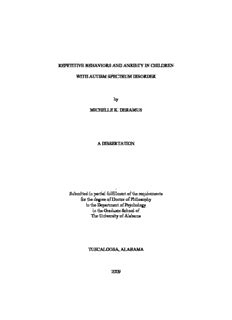
REPETITIVE BEHAVIORS AND ANXIETY IN CHILDREN WITH AUTISM SPECTRUM DISORDER ... PDF
Preview REPETITIVE BEHAVIORS AND ANXIETY IN CHILDREN WITH AUTISM SPECTRUM DISORDER ...
REPETITIVE BEHAVIORS AND ANXIETY IN CHILDREN WITH AUTISM SPECTRUM DISORDER by MICHELLE K. DERAMUS A DISSERTATION . Submitted in partial fulfillment of the requirements for the degree of Doctor of Philosophy in the Department of Psychology in the Graduate School of The University of Alabama TUSCALOOSA, ALABAMA 2009 Copyright Michelle K. DeRamus 2009 ALL RIGHTS RESERVED ABSTRACT There has been limited research on repetitive behaviors in autism spectrum disorder (ASD) with little information about how repetitive behaviors in ASD differ from repetitive behaviors in other disorders, particularly obsessive-compulsive disorder (OCD). Further, there has been little research examining how repetitive behaviors are related to the social impairments characterizing ASD. This study examined the relation between repetitive behaviors, anxiety, and social problems in ASD, as well as symptoms that differentiate ASD and OCD. Parents of 49 children with ASD and 12 children with OCD completed interviews and surveys regarding their children’s repetitive behaviors (Children’s Yale-Brown Obsessive Compulsive Scale; Repetitive Behaviors Scale – Revised), anxiety (Spence Children’s Anxiety Scale for Parents), and social impairment (Social Responsiveness Scale). Within the ASD group, approximately half of participants were reported to have clinically significant levels of anxiety. Mediation analyses provided some support for Baron-Cohen’s (1989) model suggesting that social difficulties lead to anxiety, producing repetitive behaviors in individuals with ASD. However, there was more support for an alternate mediation model suggesting that anxiety leads to repetitive behaviors, creating social problems. Both models support theories suggesting that anxiety leads to repetitive behaviors in children with ASD. The current study provides converging evidence that anxiety is a significant clinical issue for many children with ASD and is related to core social symptoms. Multivariate analysis of variance and qualitative descriptions were used to compare children with ASD and children with OCD. Results indicated that the severity and frequency of ii most types of repetitive behaviors are comparable in children with ASD and children with OCD. However, differences were evident between groups on the number of obsessions (more in OCD) and on stereotyped and restricted behavior (greater frequency and severity in ASD). The distinction between groups on these symptoms suggests that they may be useful in differentiating ASD from other disorders. A significant number (74%) of children with ASD met criteria for OCD, suggesting that it may be appropriate to use both diagnoses in the same individual. This research has implications for our conceptualization of repetitive behaviors in ASD and our assessment and treatment of children with this disorder. iii DEDICATION This dissertation is dedicated to my incredible husband Jeffrey, my family, and my friends who have provided countless hours of support, encouragement, and love over the years. iv LIST OF ABBREVIATIONS AND SYMBOLS B Unstandardized multiple regression coefficient df Degrees of freedom F Fisher’s F ratio M Mean (arithmetic average) MANOVA Multivariate analysis of variance MANCOVA Multivariate analysis of covariance n Number in a subsample N Total number in a sample p Probability r Pearson product-moment correlation R2 Multiple correlation squared; measure of strength of relationship SD Standard deviation SE B Standard error of B t Computed value of t test z A standard score α Alpha; Cronbach’s index of internal consistency β Beta; standardized multiple regression coefficient η 2 Partial eta squared; measure of strength of relationship p v ACKNOWLEDGMENTS I would like to express my gratitude to Laura Klinger, chairperson of this dissertation, for her guidance and mentorship in the development of my research and clinical skills throughout my graduate career. I would also like to thank my committee members, Angie Barber, Jim Hamilton, John Lochman, and Beverly Roskos-Ewoldson for their invaluable input, especially regarding participant recruitment and revisions to analytical approaches for this project. In addition, I am grateful to Jamie DeCoster and Mark Klinger for their consultation on statistical analysis. Data collection for this project would not have been possible without the support of my internship mentors, Gary Mesibov, Lee Marcus, and Elaine Coonrod at TEACCH at the University of North Carolina at Chapel Hill. The assistance and support I received from them, as well as from all other TEACCH staff, was crucial to the completion of this project and to my professional development. I would also like to thank the many researchers, support group leaders, and therapists throughout the country who advertised my study and aided in recruitment. I am indebted to Hannah Harwood for her contribution to data collection for this project. Finally, I would like to express my deepest thanks to all of the families who volunteered their time to participate in this study. vi CONTENTS ABSTRACT ................................................................................................ ii DEDICATION ........................................................................................... iv LIST OF ABBREVIATIONS AND SYMBOLS ........................................v ACKNOWLEDGMENTS ......................................................................... vi LIST OF TABLES ................................................................................... viii LIST OF FIGURES ................................................................................... ix 1. INTRODUCTION ...................................................................................1 2. METHODS ............................................................................................33 3. RESULTS ..............................................................................................47 4. DISCUSSION ........................................................................................74 REFERENCES ..........................................................................................93 vii LIST OF TABLES 1. Participant Characteristics…………………………………………………………………….38 2. CY-BOCS Calculations……………………………………………………………………….48 3. RBS-R Calculations…………………………………………………………………………...49 4. Repetitive Behaviors Severity Composite, SCAS-P, and SRS Calculations………………….52 5. CY-BOCS and RBS-R Correlations…………………………………………………………..55 6. Correlations between Repetitive Behaviors, Social Problems, and Anxiety………………….56 7. Mediation Model 1: Anxiety Mediates the Relation between Social Problems and Repetitive Behavior………………………………………………………………………………………….58 8. Mediation Model 2: Repetitive Behavior Mediates the Relation between Anxiety and Social Problems…………………………………………………………………………………………60 9. Characteristics of ASD Groups with and without OCD………………………………………70 10. Calculations on Primary Study Measures for ASD Groups with and without OCD………...71 viii LIST OF FIGURES 1. Model based on ASD literature with anxiety mediating the relation between social problems and repetitive behaviors ............................................................................................................... 30 2. Model based on OCD literature with repetitive behaviors mediating the relation between anxiety and social problems ......................................................................................................... 31 3. Percent of participants endorsing each Obsessions category on the CY-BOCS Symptom Checklist ...................................................................................................................................... 65 4. Percent of participants endorsing each Compulsions category on the CY-BOCS Symptom Checklist ...................................................................................................................................... 66 5. Percent of participants endorsing each subscale on the RBS-R .............................................. 67 ix
Description: